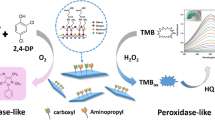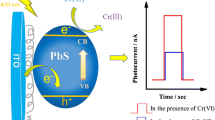Abstract
The cathodic electrochemiluminescence (ECL) behavior of meso-tetra(4-sulfonatophenyl)porphyrin (TSPP) with potassium peroxydisulfate (K2S2O8) as the coreactant in aqueous solution with strong and stable emission was exploited to determine Cu2+ down to nanomolar concentration. Two possible reaction mechanisms have been proposed to understand the generation of ECL by the TSPP/K2S2O8 system. The effects of the concentration of TSPP and K2S2O8, pH of the medium, and scan rate on the ECL intensity were studied in detail. The ECL intensity was efficiently quenched by trace amounts of Cu2+. This phenomenon was used to develop a new method, which can offer rapid, reliable, and selective detection of Cu2+. Under the optimum conditions, plots of the ECL of the TSPP/K2S2O8 system versus the concentration of Cu2+ are linear in the range of 5 to 160 nM with a detection limit of 1.56 nM (S/N = 3). The proposed ECL sensor was successfully applied for analysis of tap and river water samples. It is anticipated that TSPP could be a new class of promising luminescent agent for ECL sensors.

A two-step cathodic elelctrochemiluminescence (ECL) behavior of TSPP/K2S2O8 system in the aqueous solution and Cu2+ determination using the same








Similar content being viewed by others
References
Bard AJ. Electrogenerated chemiluminescence. New York: Dekker; 2004.
Richter MM. Electrochemiluminescence (ECL). Chem Rev. 2004;104(6):3003–36.
Dini D. Electrochemiluminescence from organic emitters. Chem Mater. 2005;17(8):1933–45.
Yin XB, Dong S, Wang E. Analytical applications of the electrochemiluminescence of tris(2,2′-bipyridyl)ruthenium and its derivatives. TrAC Trends Anal Chem. 2004;23(6):432–41.
Gerardi RD, Barnett NW, Lewis SW. Analytical applications of tris(2,2′-bipyridyl)ruthenium (III) as a chemiluminescent reagent. Anal Chim Acta. 1999;378(1):1–41.
Miao W. Electrogenerated chemiluminescence and its biorelated applications. Chem Rev. 2008;108(7):2506–53.
Bertolino C, MacSweeney M, Tobin J, et al. A monolithic silicon based integrated signal generation and detection system for monitoring DNA hybridisation. Biosens Bioelectron. 2005;21(4):565–73.
Ding C, Ge Y, Zhang S. Electrochemical and electrochemiluminescence determination of cancer cells based on aptamers and magnetic beads. Chem Eur J. 2010;16(35):10707–14.
Rivera VR, Gamez FJ, Keener WK, et al. Rapid detection of Clostridium botulinum toxins A, B, E, and F in clinical samples, selected food matrices, and buffer using paramagnetic bead-based electrochemiluminescence detection. Anal Biochem. 2006;353(2):248–56.
Huang B, Zhou X, Xue Z, et al. Quenching of the electrochemiluminescence of Ru(bpy)3 2+/TPA by malachite green and crystal violet. Talanta. 2013;106:174–80.
Zhang M, Ge L, Ge S, et al. Three-dimensional paper-based electrochemiluminescence device for simultaneous detection of Pb2+ and Hg2+ based on potential-control technique. Biosens Bioelectron. 2013;41:544–50.
Su Q, Xing D, Zhou X. Magnetic beads based rolling circle amplification- electrochemiluminescence assay for highly sensitive detection of point mutation. Biosens Bioelectron. 2010;25(7):1615–21.
Chen FC, Ho JH, Chen CY, et al. Electrogenerated chemiluminescence of sterically hindered porphyrins in aqueous media. J Electroanal Chem. 2001;499(1):17–23.
Venkataramanan NS, Kuppuraj G, Rajagopal S. Metal–salen complexes as efficient catalysts for the oxygenation of heteroatom containing organic compounds—synthetic and mechanistic aspects. Coord Chem Rev. 2005;249(11):1249–68.
Dunbar ADF, Brittle S, Richardson TH, et al. Detection of volatile organic compounds using porphyrin derivatives. J Phys Chem B. 2010;114(36):11697–702.
Brun AM, Harriman A. Energy-and electron-transfer processes involving palladium porphyrins bound to DNA. J Am Chem Soc. 1994;116(23):10383–93.
Wang W, Shan D, Yang Y, et al. A novel method for dynamic investigations of photoinduced electron transport using functionalized-porphyrin at ITO/liquid interface. Chem Commun. 2011;47(24):6975–7.
Lu X, Zhang L, Li M, et al. Electrochemical characterization of self-assembled thiol-porphyrin monolayers on gold electrodes by SECM. ChemPhysChem. 2006;7(4):854–62.
Aviv I, Gross Z. Iron corroles and porphyrins as very efficient and highly selective catalysts for the reactions of α-diazo esters with amines. Synlett. 2006;6:951–3.
Hod I, Sampson MD, Deria P, et al. Fe-porphyrin-based metal–organic framework films as high-surface concentration, heterogeneous catalysts for electrochemical reduction of CO2. ACS Catal. 2015;5(11):6302–9.
Lin S, Diercks CS, Zhang YB, et al. Covalent organic frameworks comprising cobalt porphyrins for catalytic CO2 reduction in water. Science. 2015;349(6253):1208–13.
Constantin C, Neagu M. Fluorescent porphyrin with an increased uptake in peripheral blood cell subpopulations from colon cancer patients. Med Chem. 2015;11(4):354–63.
Tokel NE, Keszthelyi CP, Bard AJ. Electrogenerated chemiluminescence. X. α, β, γ, δ-Tetraphenylporphine chemiluminescence. J Am Chem Soc. 1972;94(14):4872–7.
Tokel-Takvoryan NE, Bard AJ. Electrogenerated chemiluminescence. XVI. ECL of palladium and platinum α, β, γ, δ-tetraphenylporphyrin complexes. Chem Phys Lett. 1974;25(2):235–8.
Vogler A, Kunkely H. Electrochemiluminescence of tetrakis(diphosphonato)diplatinate(II). Angew Chem Int Ed Engl. 1984;23(4):316–7.
Bolin A, Richter MM. Coreactant electrogenerated chemiluminescence of ruthenium porphyrins. Inorg Chim Acta. 2009;362(6):1974–6.
Wu L, Wang J, Feng L, et al. Label-free ultrasensitive detection of human telomerase activity using porphyrin-functionalized graphene and electrochemiluminescence technique. Adv Mater. 2012;24(18):2447–52.
Zhang GY, Deng SY, Zhang XJ, et al. Cathodic electrochemiluminescence of singlet oxygen induced by the electroactive zinc porphyrin in aqueous media. Electrochim Acta. 2016;190:64–8.
Xu N, Lei J, Wang Q, et al. Dendritic DNA–porphyrin as mimetic enzyme for amplified fluorescent detection of DNA. Talanta. 2016;150:661–5.
Long TR, Richter MM. Electrogenerated chemiluminescence of the platinum (II) octaethylporphyrin/tri-n-propylamine system. Inorg Chim Acta. 2005;358(6):2141–5.
Luo D, Huang B, Wang L, et al. Cathodic electrochemiluminescence of meso-tetra(4-carboxyphenyl)porphyrin/potassium peroxydisulfate system in aqueous media. Electrochim Acta. 2015;151:42–9.
Cheng C, Huang Y, Tian X, et al. Electrogenerated chemiluminescence behavior of graphite-like carbon nitride and its application in selective sensing Cu2+. Anal Chem. 2012;84(11):4754–9.
Tian J, Liu Q, Asiri AM, et al. Ultrathin graphitic carbon nitride nanosheet: a highly efficient fluorosensor for rapid, ultrasensitive detection of Cu2+. Anal Chem. 2013;85(11):5595–9.
Cheng N, Jiang P, Liu Q, et al. Graphitic carbon nitride nanosheets: one-step, high-yield synthesis and application for Cu2+ detection. Analyst. 2014;139(20):5065–8.
Lindsey JS, Schreiman IC, Hsu HC, et al. Rothemund and Adler-Longo reactions revisited: synthesis of tetraphenylporphyrins under equilibrium conditions. J Org Chem. 1987;52(5):827–36.
Lindsey JS, MacCrum KA, Tyhonas JS, et al. Investigation of a synthesis of meso-porphyrins employing high concentration conditions and an electron transport chain for aerobic oxidation. J Org Chem. 1994;59(3):579–87.
Lu X, Wang H, Du J, et al. Self-quenching in the electrochemiluminescence of tris(2,2′-bipyridyl) ruthenium(II) using metabolites of catecholamines as coreactants. Analyst. 2012;137(6):1416–20.
He Q. Effect of the local environment on the structure and reactivity of metalloporphyrins. Science: Department of Chemistry. Ph.d. Thesis. 2010.
Vinyard DJ, Swavey S, Richter MM. Photoluminescence and electrogenerated chemiluminescence of a bis(bipyridyl)ruthenium (II)–porphyrin complex. Inorg Chim Acta. 2007;360(5):1529–34.
Wang Y, Lu J, Tang L, et al. Graphene oxide amplified electrogenerated chemiluminescence of quantum dots and its selective sensing for glutathione from thiol-containing compounds. Anal Chem. 2009;81(23):9710–5.
Chen Y, Shen Y, Sun D, et al. Fabrication of a dispersible graphene/gold nanoclusters hybrid and its potential application in electrogenerated chemiluminescence. Chem Commun. 2011;47(42):11733–5.
White HS, Bard AJ. Electrogenerated chemiluminescence. 41. Electrogenerated chemiluminescence and chemiluminescence of the Ru (2,21-bpy) 3 2+-S2O8 2−system in acetonitrile-water solutions. J Am Chem Soc. 1982;104(25):6891–5.
Liang G, Shen L, Zou G, et al. Efficient near-infrared electrochemiluminescence from CdTe nanocrystals with low triggering potential and ultrasensitive sensing ability. Chem Eur J. 2011;17(37):10213–5.
Bae Y, Myung N, Bard AJ. Electrochemistry and electrogenerated chemiluminescence of CdTe nanoparticles. Nano Lett. 2004;4(6):1153–61.
Yao W, Wang L, Wang H, et al. Cathodic electrochemiluminescence behavior of norfloxacin/peroxydisulfate system in purely aqueous solution. Electrochim Acta. 2008;54(2):733–7.
Yu S, Zhou Q, Zhao XM, et al. Comparison of the antiviral effects of different nucleos(t)ide analogues in Chinese patients with chronic hepatitis B: a head-to-head study. Saudi J Gastroenterol. 2014;20(6):350.
Chen Z, Wong KMC, Kwok ECH, et al. Electrogenerated chemiluminescence of platinum(II) alkynyl terpyridine complex with peroxydisulfate as coreactant. Inorg Chem. 2011;50(6):2125–32.
Hua L, Han H, Chen H. Enhanced electrochemiluminescence of CdTe quantum dots with carbon nanotube film and its sensing of methimazole. Electrochim Acta. 2009;54(5):1389–94.
Dai H, Chi Y, Wu X, et al. Biocompatible electrochemiluminescent biosensor for choline based on enzyme/titanate nanotubes/chitosan composite modified electrode. Biosens Bioelectron. 2010;25(6):1414–9.
Shang Q, Zhou Z, Shen Y, et al. Potential-modulated electrochemiluminescence of carbon nitride nanosheets for dual-signal sensing of metal ions. ACS Appl Mater Interface. 2015;7(42):23672–8.
De Silva AP, Gunaratne HQN, Gunnlaugsson T, et al. Signaling recognition events with fluorescent sensors and switches. Chem Rev. 1997;97(5):1515–66.
Luo HY, Zhang XB, Jiang JH, et al. An optode sensor for Cu2+ with high selectivity based on porphyrin derivative appended with bipyridine. Anal Sci. 2007;23(5):551–5.
Ghosh I, Saleh N, Nau WM. Selective time-resolved binding of copper (II) by pyropheophorbide-a methyl ester. Photochem Photobiol Sci. 2010;9(5):649–54.
Hu M, Li H, Chen L, et al. Fluorescence quenching of pheophytin-a by copper (II) ions. Chin J Chem. 2009;27(3):513–7.
Domingues MRM, Santana-Marques MG, Ferrer-Correia AJ. Formation of metalloporphyrins and metallochlorins in the source of a mass spectrometer under fast atom bombardment. Int J Mass Spectrom Ion Process. 1997;165–166:551–9.
Giovannetti R, Bartocci V, Ferraro S, Gusteri M, Passamonti P. Spectrophotometric study of coproporphyrin-I complexes of copper(II) and cobalt(II). Talanta. 1995;42:1913–8.
Hu MB, Li HX, Chen LS, Zhang HB, Dong C. Fluorescence quenching of pheophytin-a by copper(II) ions. Chin J Chem. 2009;27:513–7.
Acknowledgments
This work was supported by the Natural Science Foundation of China (grant nos. 21575115, 21327005, 21175108); the Program for Chang Jiang Scholars and Innovative Research Team, Ministry of Education, China (grant no. IRT1283); the Program for Innovative Research Group of Gansu Province, China (grant no. 1210RJIA001).
Author information
Authors and Affiliations
Corresponding author
Ethics declarations
Conflict of interest
The authors declare that they have no competing interests.
Additional information
Published in the topical collection Analytical Electrochemiluminescence with guest editors Hua Cui, Francesco Paolucci, Neso Sojic, and Guobao Xu.
Electronic supplementary material
Below is the link to the electronic supplementary material.
ESM 1
(PDF 166 kb)
Rights and permissions
About this article
Cite this article
Zhang, J., Devaramani, S., Shan, D. et al. Electrochemiluminescence behavior of meso-tetra(4-sulfonatophenyl)porphyrin in aqueous medium: its application for highly selective sensing of nanomolar Cu2+ . Anal Bioanal Chem 408, 7155–7163 (2016). https://doi.org/10.1007/s00216-016-9655-0
Received:
Revised:
Accepted:
Published:
Issue Date:
DOI: https://doi.org/10.1007/s00216-016-9655-0




